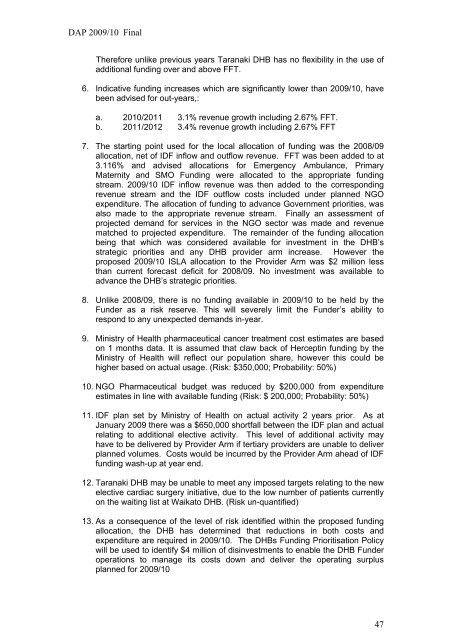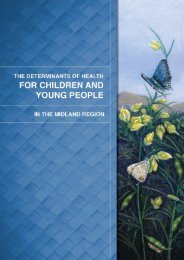DAP 2009/10 Final 1 - Taranaki District Health Board
DAP 2009/10 Final 1 - Taranaki District Health Board
DAP 2009/10 Final 1 - Taranaki District Health Board
You also want an ePaper? Increase the reach of your titles
YUMPU automatically turns print PDFs into web optimized ePapers that Google loves.
<strong>DAP</strong> <strong>2009</strong>/<strong>10</strong> <strong>Final</strong>Therefore unlike previous years <strong>Taranaki</strong> DHB has no flexibility in the use ofadditional funding over and above FFT.6. Indicative funding increases which are significantly lower than <strong>2009</strong>/<strong>10</strong>, havebeen advised for out-years,:a. 20<strong>10</strong>/2011 3.1% revenue growth including 2.67% FFT.b. 2011/2012 3.4% revenue growth including 2.67% FFT7. The starting point used for the local allocation of funding was the 2008/09allocation, net of IDF inflow and outflow revenue. FFT was been added to at3.116% and advised allocations for Emergency Ambulance, PrimaryMaternity and SMO Funding were allocated to the appropriate fundingstream. <strong>2009</strong>/<strong>10</strong> IDF inflow revenue was then added to the correspondingrevenue stream and the IDF outflow costs included under planned NGOexpenditure. The allocation of funding to advance Government priorities, wasalso made to the appropriate revenue stream. <strong>Final</strong>ly an assessment ofprojected demand for services in the NGO sector was made and revenuematched to projected expenditure. The remainder of the funding allocationbeing that which was considered available for investment in the DHB’sstrategic priorities and any DHB provider arm increase. However theproposed <strong>2009</strong>/<strong>10</strong> ISLA allocation to the Provider Arm was $2 million lessthan current forecast deficit for 2008/09. No investment was available toadvance the DHB’s strategic priorities.8. Unlike 2008/09, there is no funding available in <strong>2009</strong>/<strong>10</strong> to be held by theFunder as a risk reserve. This will severely limit the Funder’s ability torespond to any unexpected demands in-year.9. Ministry of <strong>Health</strong> pharmaceutical cancer treatment cost estimates are basedon 1 months data. It is assumed that claw back of Herceptin funding by theMinistry of <strong>Health</strong> will reflect our population share, however this could behigher based on actual usage. (Risk: $350,000; Probability: 50%)<strong>10</strong>. NGO Pharmaceutical budget was reduced by $200,000 from expenditureestimates in line with available funding (Risk: $ 200,000; Probability: 50%)11. IDF plan set by Ministry of <strong>Health</strong> on actual activity 2 years prior. As atJanuary <strong>2009</strong> there was a $650,000 shortfall between the IDF plan and actualrelating to additional elective activity. This level of additional activity mayhave to be delivered by Provider Arm if tertiary providers are unable to deliverplanned volumes. Costs would be incurred by the Provider Arm ahead of IDFfunding wash-up at year end.12. <strong>Taranaki</strong> DHB may be unable to meet any imposed targets relating to the newelective cardiac surgery initiative, due to the low number of patients currentlyon the waiting list at Waikato DHB. (Risk un-quantified)13. As a consequence of the level of risk identified within the proposed fundingallocation, the DHB has determined that reductions in both costs andexpenditure are required in <strong>2009</strong>/<strong>10</strong>. The DHBs Funding Prioritisation Policywill be used to identify $4 million of disinvestments to enable the DHB Funderoperations to manage its costs down and deliver the operating surplusplanned for <strong>2009</strong>/<strong>10</strong>47
















